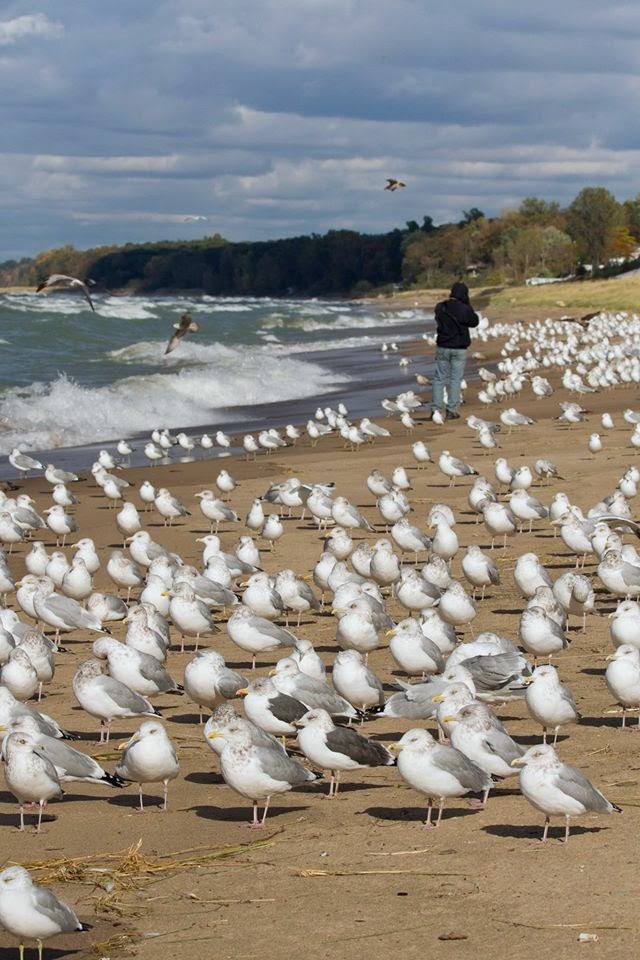This first weekend of October was eventful and full of interesting gulls, to say the least. Let's start with the title birds - straightforward and no ID issues.
Somewhat of a surprise is this adult Thayer's. I have always looked for Thayer's in early November and late October, but seeing that states to our north (particularly Duluth, MN) see them as early as late September, I purposefully decided to go looking for Thayer's this weekend.
 |
Adult type Thayer's Gull. Lake County, Illinois. 04 October 2015.
This is now my earliest arrival for this species. Prior to this my earliest was 19 October 2013 in Illinois & 18 October 2014 in Indiana.
|
Notice p10 is still hanging on. Usually, when we see our first adult THGUs, they've dropped p10 and are about halfway done growing p9 with small hints of the tip to a new p10.
Next up was my first juvenile Lesser Black-backed for the season (adults and sub-adults have been here for at least a month):
It's interesting that sites to our east (southern Ontario and New England) begin reporting these juveniles the first week of September. I usually don't find my first juveniles until about mid-October.
 |
| Juvenile LBBG. 100% juvenile. New Buffalo, Michigan. 03 October 2015 |
The Weirdos
Now for my "interesting" gulls. This first individual tripped me up for a few hours, leading me to think it may be a California Gull, but I've retracted that ID. I believe it's a somewhat atypical Herring or perhaps even a CAGU x HERG (a hybrid that's now being reported with some regularity in Colorado):
The medium gray scaps have dark-centered shaft streaks and overall did not look like any Herrings I've been seeing (until the day after, of course). The bicolored bill is small, the gape appears to frown down (like CAGU) and the tibia shows hits of blue.
 |
| Same individual above. LWHG. New Buffalo, Michigan. 05 October 2015. |
I suppose everything on this bird can be found in typical Herrings, but there was something about it - an initial instinct - that looked different, structure and size too. Unfortunately, it was raining, windy and my autofocus wasn't working (and still isn't), so no flight shots. It did appear to have inner primaries that lightly contrasted with the outers, but not a full-blown pale window that is generally found in Herring Gull. I don't recall it having a strong "second" secondary bar formed by dark greater covert bases.
Some history: I've found 3 California Gulls at this site in the last few years (all in October). It seems this is the month they move in with the Herrings. I'm under the impression that there may be some young individuals that are hybrids/backcrosses (perhaps from Alberta or thereabouts) that are migrating with the larger parent species. This may all sound like a stretch, but if putative adult hybrid CAGU x HERGs are being found, I think it behooves us to put young birds on our radar. Here's an example of an adult hybrid:
http://goo.gl/Qmvwqh
More Weirdos
I've identified all of the individuals below as Herring Gulls, some less obvious than others. Al of these birds were photographed in Lake County, Illinois on 04 October 2015.
 |
| 2nd cycle Herring. A very fine pattern of barring to the pale upperparts. |
 |
| White head, frosty 2nd generation scaps. |
 |
| White body, worn wing covets and dark 2nd generation scaps. The scaps are patterned with a medium gray color. Longer than expected wing projections. |
 |
Medium gray 2nd generation scaps. Wing coverts are plain and appear subdued (faded already?). The overall solid caramel color to this bird appeared different. The color to the primaries is lighter than the bill.
|
 |
Again, medium gray color to the 2nd generation scaps. The fine "zig-zag" pattern to the wing coverts looks like something one would find on a Glaucous Gull (but of course much paler).
|
 |
1 of only 2 birds with nearly all juvenile scapulars. It's fair to assume this individual is a late hatch. Or, does it have a more durable juvenile plumage and originates from a much more northern latitude than all of the early molters?
|
 |
The 2nd bird of the day to have almost complete juvenile scapulars (less a few newers scaps growing in adjacent to the hindneck). This one looks like it could be siblings with the bird above.
|
The Weirdest
 |
| A one-eyed adult that was coming along, I guess. |
 |
| A first for me, this bird has a leucistic left wing and a normal right wing. One would never know if they were only scanning from its right side. |
 |
| Finally, a cross-dresser. Not doing a very good job of trying to disguise itself as a Ring-billed. |













